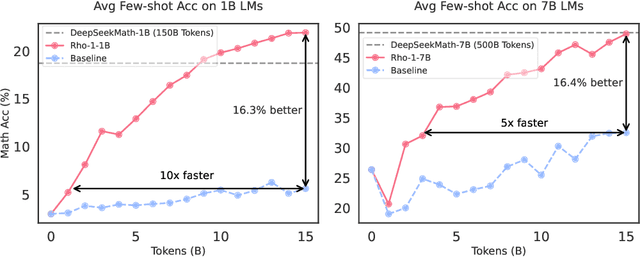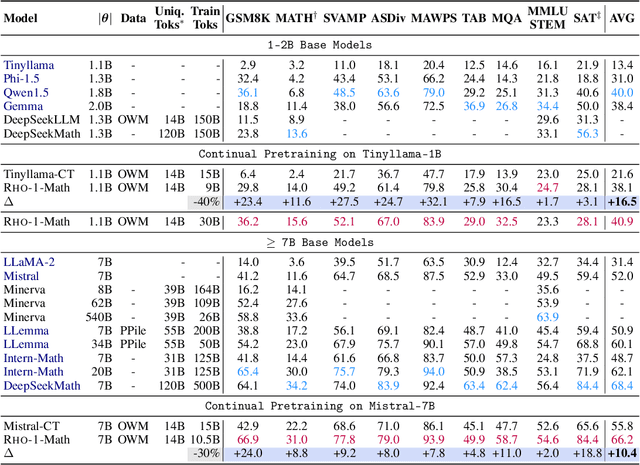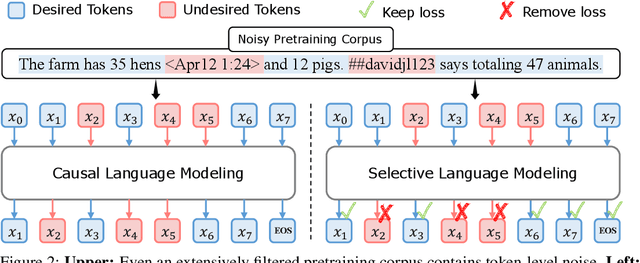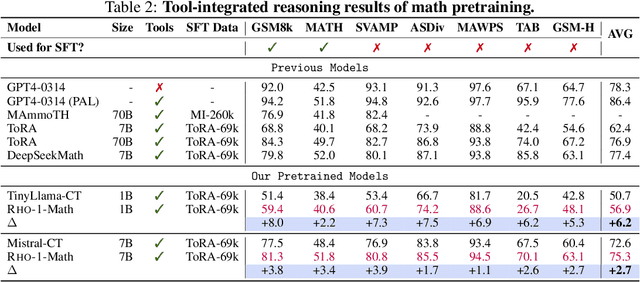Zhenghao Lin
Sigma: Differential Rescaling of Query, Key and Value for Efficient Language Models
Jan 23, 2025



Abstract:We introduce Sigma, an efficient large language model specialized for the system domain, empowered by a novel architecture including DiffQKV attention, and pre-trained on our meticulously collected system domain data. DiffQKV attention significantly enhances the inference efficiency of Sigma by optimizing the Query (Q), Key (K), and Value (V) components in the attention mechanism differentially, based on their varying impacts on the model performance and efficiency indicators. Specifically, we (1) conduct extensive experiments that demonstrate the model's varying sensitivity to the compression of K and V components, leading to the development of differentially compressed KV, and (2) propose augmented Q to expand the Q head dimension, which enhances the model's representation capacity with minimal impacts on the inference speed. Rigorous theoretical and empirical analyses reveal that DiffQKV attention significantly enhances efficiency, achieving up to a 33.36% improvement in inference speed over the conventional grouped-query attention (GQA) in long-context scenarios. We pre-train Sigma on 6T tokens from various sources, including 19.5B system domain data that we carefully collect and 1T tokens of synthesized and rewritten data. In general domains, Sigma achieves comparable performance to other state-of-arts models. In the system domain, we introduce the first comprehensive benchmark AIMicius, where Sigma demonstrates remarkable performance across all tasks, significantly outperforming GPT-4 with an absolute improvement up to 52.5%.
Collaborative Optimization in Financial Data Mining Through Deep Learning and ResNeXt
Dec 23, 2024Abstract:This study proposes a multi-task learning framework based on ResNeXt, aiming to solve the problem of feature extraction and task collaborative optimization in financial data mining. Financial data usually has the complex characteristics of high dimensionality, nonlinearity, and time series, and is accompanied by potential correlations between multiple tasks, making it difficult for traditional methods to meet the needs of data mining. This study introduces the ResNeXt model into the multi-task learning framework and makes full use of its group convolution mechanism to achieve efficient extraction of local patterns and global features of financial data. At the same time, through the design of task sharing layers and dedicated layers, it is established between multiple related tasks. Deep collaborative optimization relationships. Through flexible multi-task loss weight design, the model can effectively balance the learning needs of different tasks and improve overall performance. Experiments are conducted on a real S&P 500 financial data set, verifying the significant advantages of the proposed framework in classification and regression tasks. The results indicate that, when compared to other conventional deep learning models, the proposed method delivers superior performance in terms of accuracy, F1 score, root mean square error, and other metrics, highlighting its outstanding effectiveness and robustness in handling complex financial data. This research provides an efficient and adaptable solution for financial data mining, and at the same time opens up a new research direction for the combination of multi-task learning and deep learning, which has important theoretical significance and practical application value.
Integrative Analysis of Financial Market Sentiment Using CNN and GRU for Risk Prediction and Alert Systems
Dec 13, 2024Abstract:This document presents an in-depth examination of stock market sentiment through the integration of Convolutional Neural Networks (CNN) and Gated Recurrent Units (GRU), enabling precise risk alerts. The robust feature extraction capability of CNN is utilized to preprocess and analyze extensive network text data, identifying local features and patterns. The extracted feature sequences are then input into the GRU model to understand the progression of emotional states over time and their potential impact on future market sentiment and risk. This approach addresses the order dependence and long-term dependencies inherent in time series data, resulting in a detailed analysis of stock market sentiment and effective early warnings of future risks.
Revolutionizing Database Q&A with Large Language Models: Comprehensive Benchmark and Evaluation
Sep 05, 2024Abstract:The development of Large Language Models (LLMs) has revolutionized Q&A across various industries, including the database domain. However, there is still a lack of a comprehensive benchmark to evaluate the capabilities of different LLMs and their modular components in database Q&A. To this end, we introduce DQA, the first comprehensive database Q&A benchmark. DQA features an innovative LLM-based method for automating the generation, cleaning, and rewriting of database Q&A, resulting in over 240,000 Q&A pairs in English and Chinese. These Q&A pairs cover nearly all aspects of database knowledge, including database manuals, database blogs, and database tools. This inclusion allows for additional assessment of LLMs' Retrieval-Augmented Generation (RAG) and Tool Invocation Generation (TIG) capabilities in the database Q&A task. Furthermore, we propose a comprehensive LLM-based database Q&A testbed on DQA. This testbed is highly modular and scalable, with both basic and advanced components like Question Classification Routing (QCR), RAG, TIG, and Prompt Template Engineering (PTE). Besides, DQA provides a complete evaluation pipeline, featuring diverse metrics and a standardized evaluation process to ensure comprehensiveness, accuracy, and fairness. We use DQA to evaluate the database Q&A capabilities under the proposed testbed comprehensively. The evaluation reveals findings like (i) the strengths and limitations of nine different LLM-based Q&A bots and (ii) the performance impact and potential improvements of various service components (e.g., QCR, RAG, TIG). We hope our benchmark and findings will better guide the future development of LLM-based database Q&A research.
Rho-1: Not All Tokens Are What You Need
Apr 11, 2024



Abstract:Previous language model pre-training methods have uniformly applied a next-token prediction loss to all training tokens. Challenging this norm, we posit that "Not all tokens in a corpus are equally important for language model training". Our initial analysis delves into token-level training dynamics of language model, revealing distinct loss patterns for different tokens. Leveraging these insights, we introduce a new language model called Rho-1. Unlike traditional LMs that learn to predict every next token in a corpus, Rho-1 employs Selective Language Modeling (SLM), which selectively trains on useful tokens that aligned with the desired distribution. This approach involves scoring pretraining tokens using a reference model, and then training the language model with a focused loss on tokens with higher excess loss. When continual pretraining on 15B OpenWebMath corpus, Rho-1 yields an absolute improvement in few-shot accuracy of up to 30% in 9 math tasks. After fine-tuning, Rho-1-1B and 7B achieved state-of-the-art results of 40.6% and 51.8% on MATH dataset, respectively - matching DeepSeekMath with only 3% of the pretraining tokens. Furthermore, when pretraining on 80B general tokens, Rho-1 achieves 6.8% average enhancement across 15 diverse tasks, increasing both efficiency and performance of the language model pre-training.
Ensuring Safe and High-Quality Outputs: A Guideline Library Approach for Language Models
Mar 23, 2024Abstract:Large Language Models (LLMs) exhibit impressive capabilities but also present risks such as biased content generation and privacy issues. One of the current alignment techniques includes principle-driven integration, but it faces challenges arising from the imprecision of manually crafted rules and inadequate risk perception in models without safety training. To address these, we introduce Guide-Align, a two-stage approach. Initially, a safety-trained model identifies potential risks and formulates specific guidelines for various inputs, establishing a comprehensive library of guidelines and a model for input-guidelines retrieval. Subsequently, the retrieval model correlates new inputs with relevant guidelines, which guide LLMs in response generation to ensure safe and high-quality outputs, thereby aligning with human values. An additional optional stage involves fine-tuning a model with well-aligned datasets generated through the process implemented in the second stage. Our method customizes guidelines to accommodate diverse inputs, thereby enhancing the fine-grainedness and comprehensiveness of the guideline library. Furthermore, it incorporates safety expertise from a safety-trained LLM through a lightweight retrieval model. We evaluate our approach on three benchmarks, demonstrating significant improvements in LLM security and quality. Notably, our fine-tuned model, Labrador, even at 13 billion parameters, outperforms GPT-3.5-turbo and surpasses GPT-4 in alignment capabilities.
Competition-Level Problems are Effective LLM Evaluators
Dec 05, 2023Abstract:Large language models (LLMs) have demonstrated impressive reasoning capabilities, yet there is ongoing debate about these abilities and the potential data contamination problem recently. This paper aims to evaluate the reasoning capacities of LLMs, specifically in solving recent competition-level programming problems in Codeforces, which are expert-crafted and unique, requiring deep understanding and robust reasoning skills. We first provide a comprehensive evaluation of GPT-4's peiceived zero-shot performance on this task, considering various aspects such as problems' release time, difficulties, and types of errors encountered. Surprisingly, the peiceived performance of GPT-4 has experienced a cliff like decline in problems after September 2021 consistently across all the difficulties and types of problems, which shows the potential data contamination, as well as the challenges for any existing LLM to solve unseen complex reasoning problems. We further explore various approaches such as fine-tuning, Chain-of-Thought prompting and problem description simplification, unfortunately none of them is able to consistently mitigate the challenges. Through our work, we emphasis the importance of this excellent data source for assessing the genuine reasoning capabilities of LLMs, and foster the development of LLMs with stronger reasoning abilities and better generalization in the future.
On the Evaluation of Generative Models in Distributed Learning Tasks
Oct 18, 2023Abstract:The evaluation of deep generative models including generative adversarial networks (GANs) and diffusion models has been extensively studied in the literature. While the existing evaluation methods mainly target a centralized learning problem with training data stored by a single client, many applications of generative models concern distributed learning settings, e.g. the federated learning scenario, where training data are collected by and distributed among several clients. In this paper, we study the evaluation of generative models in distributed learning tasks with heterogeneous data distributions. First, we focus on the Fr\'echet inception distance (FID) and consider the following FID-based aggregate scores over the clients: 1) FID-avg as the mean of clients' individual FID scores, 2) FID-all as the FID distance of the trained model to the collective dataset containing all clients' data. We prove that the model rankings according to the FID-all and FID-avg scores could be inconsistent, which can lead to different optimal generative models according to the two aggregate scores. Next, we consider the kernel inception distance (KID) and similarly define the KID-avg and KID-all aggregations. Unlike the FID case, we prove that KID-all and KID-avg result in the same rankings of generative models. We perform several numerical experiments on standard image datasets and training schemes to support our theoretical findings on the evaluation of generative models in distributed learning problems.
AnnoLLM: Making Large Language Models to Be Better Crowdsourced Annotators
Mar 29, 2023Abstract:Many natural language processing (NLP) tasks rely on labeled data to train machine learning models to achieve high performance. However, data annotation can be a time-consuming and expensive process, especially when the task involves a large amount of data or requires specialized domains. Recently, GPT-3.5 series models have demonstrated remarkable few-shot and zero-shot ability across various NLP tasks. In this paper, we first claim that large language models (LLMs), such as GPT-3.5, can serve as an excellent crowdsourced annotator by providing them with sufficient guidance and demonstrated examples. To make LLMs to be better annotators, we propose a two-step approach, 'explain-then-annotate'. To be more precise, we begin by creating prompts for every demonstrated example, which we subsequently utilize to prompt a LLM to provide an explanation for why the specific ground truth answer/label was chosen for that particular example. Following this, we construct the few-shot chain-of-thought prompt with the self-generated explanation and employ it to annotate the unlabeled data. We conduct experiments on three tasks, including user input and keyword relevance assessment, BoolQ and WiC. The annotation results from GPT-3.5 surpasses those from crowdsourced annotation for user input and keyword relevance assessment. Additionally, for the other two tasks, GPT-3.5 achieves results that are comparable to those obtained through crowdsourced annotation.
GENIE: Large Scale Pre-training for Text Generation with Diffusion Model
Dec 22, 2022Abstract:In this paper, we propose a large-scale language pre-training for text GENeration using dIffusion modEl, which is named GENIE. GENIE is a pre-training sequence-to-sequence text generation model which combines Transformer and diffusion. The diffusion model accepts the latent information from the encoder, which is used to guide the denoising of the current time step. After multiple such denoise iterations, the diffusion model can restore the Gaussian noise to the diverse output text which is controlled by the input text. Moreover, such architecture design also allows us to adopt large scale pre-training on the GENIE. We propose a novel pre-training method named continuous paragraph denoise based on the characteristics of the diffusion model. Extensive experiments on the XSum, CNN/DailyMail, and Gigaword benchmarks shows that GENIE can achieves comparable performance with various strong baselines, especially after pre-training, the generation quality of GENIE is greatly improved. We have also conduct a lot of experiments on the generation diversity and parameter impact of GENIE. The code for GENIE will be made publicly available.
 Add to Chrome
Add to Chrome Add to Firefox
Add to Firefox Add to Edge
Add to Edge